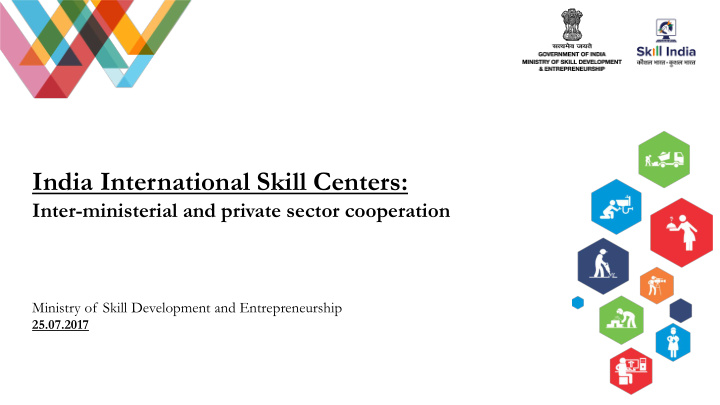



India International Skill Centers: Inter-ministerial and private sector cooperation Ministry of Skill Development and Entrepreneurship 25.07.2017
Agenda • Migration Trends • Concept of IISC • Pilot Phase and Early Results • Pre Departure Orientation Training – Cooperation with MEA • International Certification - Role of Awarding bodies • Way Forward
Migration Trends: Global • 1 in 7 people today are migrants : • International Migrants: 232 million (3.2% of world’s population) and around • Internal Migrants: 730 million (10.1% of the world’s population) • Share of international migrant as percentage of population vary across countries: • Gulf Cooperation Council • United Arab Emirates (84%) • Kuwait (60%) • Qatar (74%) • Bahrain (55%) • Traditional Destinations Australia (28%) Canada (21%) • • • Countries of Europe (~10% – 12%)
Migration Trends: India’s Labor Outflow Sector wise trend of India’s labor outflow For People with technical skills: Key Destinations: • USA, Canada, UK, EU and Australia (Permanent migrants) Key Sectors : • Healthcare, Management, Financial Services and Technology For skilled and unskilled workers: Key Destinations: • Middle East and GCC countries (Temporary contracts) Key Sectors : • Construction, Retail, Drivers
Migration Trends: India Major states contributing to migration from India Key Trends Highlighted states account for 80% of immigration from • India during 2012-14 Highest share of migration: Uttar Pradesh (25%) • Shift in Trend Relative shift in migration pattern from relatively • prosperous states (Kerala and Karnataka) to poor states (Uttar Pradesh and Bihar) Key factor • Higher literacy and income in former states leading to • better employment opportunities Increased unemployment in the latter states •
Concept of IISC: Making Skilled India World Ready Objective of IISC Provide skill trainings and certification benchmarked to International Standards to facilitate overseas mobility of Indian workforce for jobs Training Component Training on Transnational Domain Training through PMKVY • Skill Standard PDoT through PKVY (MEA) • Pre Departure Major Stakeholders Orientation Training Ministries : MSDE, MEA • GoI Bodies : NSDC, SSCs • Certification by International Partner Country’s Government Awarding Body • Private organisation : Awarding Bodies, • Training Partners Making Individuals Overseas employment ready
IISC Pilot IISC Pilot Phase 14 Centers have already commenced training • 7 more centers to commence training soon • Key Sectors : Retail : Retail Sales Associate Tourism & Hospitality : Food & Beverage Steward Domestic Workers : General Housekeeper Healthcare : General Duty Assistant Construction : General Mason Capital Goods : MIG Welder Automotive : Commercial Vehicle Driver Security : Unarmed Security Guard
IISC Pilot: Early Results • 5 batches completed and assessed • Placement to commence post the availability of assessment results • Early Placement Indicators: 3 students from General Mason course placed in UAE (pre-assessment) at starting • salary of 1400 DHM (25% higher than average salary) Recruitment Agents have given a in-principal confirmation for placement of entire • batches of domestic workers • Employers have shown a willingness to engage directly but requires further push and brand strengthening
Pre Departure Orientation Training • Pre departure orientation training (PDOT) (160 hours) • Culture and migration process (40 hours) • Language Skills (80 hours) • Digital Literacy (40 hours) • Training of Trainers for PDOT conducted by MEA • PDOT funded through Pravasi Kaushal Vikas Yojna (PKVY) by MEA at Common Norm rates • PDOT mandatory in all IISC and plans to offer it to all MEA conducting PDOT training migrant workers of trainers session
International Certification: Role of Awarding bodies Centre Accreditation Process: - Provide technical specifications for evaluation/benchmarking of IISCs Enhanced Content: - Define the standards as per country requirements and specifications - Provide enhanced content to the existing QPs to match Training of Trainer (ToT) & Assessors the international standards - ToT to master trainer - Build assessment capacity by training select assessors Assessment and certification: - Assess & certify candidates trained at IISCs on skills benchmarked to international standards - Provide international certification Quality Assurance: - Conduct an annual review on the assessors
Way Forward (1/2) • Strengthening Government to Government Partnerships • MoUs with several countries such as Qatar, Japan, Singapore etc. to push for benchmarking, mutual recognition of standards and seamless workforce migration • Engagement with recruitment industry: Multiple interactions organized to take into account expectation of recruitment agents • MEA support resulted in interaction with recruitment agents willing to provide placement • linkages Recreate their own training capacity to integrate backwards •
Way Forward (2/2) • Creating Market Models for IISC • Working towards creating new models for IISC based on skill loans, internationally accepted trade testing • Aligning all incentives to IISC with international placement outcomes • Aligning new IISC models with different awarding bodies for different requirments • New Opportunities and Geographies • Large market beyond GCC countries • Different countries to with their unique challenges: • Japan – TITP program has potential for large number but language a barrier • Jordan – Large opportunities for female Indian apparel workers
Thank You
Recommend
More recommend